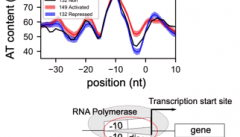
Teams
Modeling an ancestral regulation mode of bacterial promoters by DNA supercoiling
ABSTRACT
DNA supercoiling acts as a global transcriptional regulator that contributes to the rapid transcriptional response of bacteria to many environmental changes. Although a large fraction of promoters from phylogenetically distant species respond to superhelical variations, the sequence or structural determinants of this behavior remain elusive. Here, we focus on the sequence of the “discriminator” element that was shown to modulate this response in several promoters. We develop a quantitative thermodynamic model of this regulatory effect, focusing on open complex formation during transcription initiation independently from promoter-specific regulatory proteins. We analyze previous and new expression data and show that the model predictions quantitatively match the in vitro and in vivo supercoiling response of selected promoters with mutated discriminator sequences. We then test the universality of this mechanism by a statistical analysis of promoter sequences from transcriptomes of phylogenetically distant bacteria under conditions of supercoiling variations (i) by gyrase inhibitors, (ii) by environmental stresses, or (iii) inherited in the longest-running evolution experiment. In all cases, we identify a robust and significant sequence signature in the discriminator region, suggesting that supercoiling-modulated promoter opening underpins a ubiquitous regulatory mechanism in the prokaryotic kingdom based on the fundamental mechanical properties of DNA and its basal interaction with RNA polymerase.
IMPORTANCE
In this study, we highlight the role of the discriminator as a global sensor of supercoiling variations and propose the first quantitative regulatory model of this principle, based on the specific step of promoter opening during transcription initiation. It defines the predictive rule by which DNA supercoiling quantitatively modulates the expression rate of bacterial promoters, depending on the G/C content of their discriminator and independently from promoter-specific regulatory proteins. This basal mechanism affects a wide range of species, which is tested by an extensive analysis of global high-throughput expression data. Altogether, ours results confirm and provide a quantitative framework for the long-proposed notion that the discriminator sequence is a significant determinant of promoter supercoiling sensitivity, underpinning the ubiquitous regulatory action of DNA supercoiling on the core transcriptional machinery, in particular in response to quick environmental changes.

